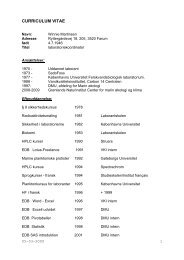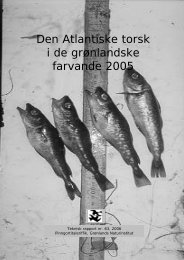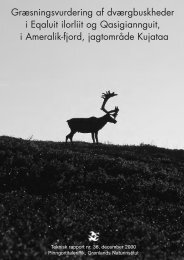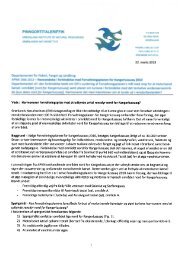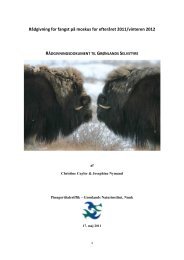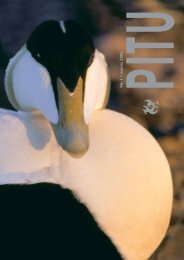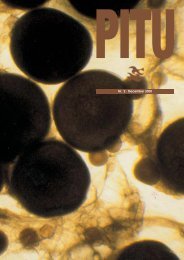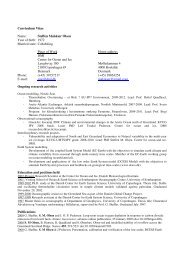Migration and breeding biology of Arctic terns in Greenland
Migration and breeding biology of Arctic terns in Greenland
Migration and breeding biology of Arctic terns in Greenland
Create successful ePaper yourself
Turn your PDF publications into a flip-book with our unique Google optimized e-Paper software.
44<br />
There is little written documentation <strong>of</strong> the Greenl<strong>and</strong> <strong>Arctic</strong> tern harvest.<br />
Salomonsen (1950) estimated the annual number <strong>of</strong> eggs harvested to be<br />
as high as 100,000, while Frich (1997) estimated that 150-200 persons visited<br />
the archipelago between 6 <strong>and</strong> 25 June 2006, <strong>and</strong> harvested between<br />
3,000 <strong>and</strong> 6,000 eggs with a harvest<strong>in</strong>g rate <strong>of</strong> 20-30 eggs per day per person.<br />
The fi rst year after the ban on egg harvest<strong>in</strong>g, 42 persons were recorded<br />
<strong>in</strong> illegal egg harvest<strong>in</strong>g activities between 18 <strong>and</strong> 24 June 2002.<br />
On 27 June 2002 two families were caught with a total <strong>of</strong> 398 boiled <strong>Arctic</strong><br />
tern eggs – collected <strong>in</strong> less than 24 hours. S<strong>in</strong>ce 2002, the level <strong>of</strong> illegal<br />
harvest<strong>in</strong>g has decl<strong>in</strong>ed at Kitsissunnguit (pers. obs.).<br />
In this study we comb<strong>in</strong>e <strong>breed<strong>in</strong>g</strong> parameters on <strong>Arctic</strong> <strong>terns</strong> obta<strong>in</strong>ed<br />
from Greenl<strong>and</strong> <strong>in</strong> a model to predict whether a susta<strong>in</strong>able egg harvest<br />
can be practiced <strong>in</strong> Greenl<strong>and</strong>. The goal <strong>of</strong> this study is to see if a balance<br />
could be found between confl ict<strong>in</strong>g <strong>in</strong>terests <strong>of</strong> egg harvest by <strong>in</strong>digenous<br />
people <strong>and</strong> preserv<strong>in</strong>g wildlife as applied <strong>in</strong> similar studies, e.g. sooty<br />
<strong>terns</strong> (Sterna fuscata) <strong>and</strong> Glaucous-w<strong>in</strong>ged gulls (Larus glaucescens) (Feare<br />
1976; Feare 1976; Zador et al. 2006). The aim is to produce recommendations<br />
for managers on how enforceable regulations can secure that egg<br />
harvest<strong>in</strong>g is still possible for local Inuit with m<strong>in</strong>imum impact on the<br />
<strong>Arctic</strong> tern population.<br />
Methods <strong>and</strong> material<br />
Study site<br />
The study was conducted between 2002 <strong>and</strong> 2006 at Kitsissunnguit<br />
(Grønne Ejl<strong>and</strong>), the largest <strong>Arctic</strong> tern colony <strong>in</strong> Greenl<strong>and</strong>. The archipelago<br />
conta<strong>in</strong>s four major isl<strong>and</strong>s <strong>and</strong> a small number <strong>of</strong> skerries <strong>and</strong> islets,<br />
<strong>and</strong> is located <strong>in</strong> the southern part <strong>of</strong> Disko Bay, West Greenl<strong>and</strong> (68˚50’N,<br />
52˚00’W). <strong>Arctic</strong> <strong>terns</strong> breed at relatively low densities throughout the <strong>in</strong>terior<br />
parts <strong>of</strong> the isl<strong>and</strong>s on habitat compris<strong>in</strong>g dwarf scrub heath.<br />
Data collection<br />
Study plots were defi ned with the tern colony, <strong>and</strong> all nests laid with<strong>in</strong><br />
these through the season were located by <strong>in</strong>tensive search<strong>in</strong>g. The clutch<br />
size <strong>of</strong> each nest was recorded <strong>and</strong> the egg length, breadth <strong>and</strong> mass was<br />
recorded us<strong>in</strong>g Vernier callipers <strong>and</strong> electronic scale with 0.1 g accuracy.<br />
Lay<strong>in</strong>g date were determ<strong>in</strong>ed by backtrack<strong>in</strong>g hatch<strong>in</strong>g dates by 22 days<br />
(Cramp 1985, Hatch 2002). Nests were enclosed with<strong>in</strong> a 5-8 meter diameter,<br />
25 cm high fence <strong>of</strong> chicken wire, with shelter for the chick be<strong>in</strong>g<br />
provided <strong>in</strong> the form <strong>of</strong> piled rocks, peat or driftwood. Nests were then<br />
checked every 1-2 days to determ<strong>in</strong>e their fate. Once the chicks hatched<br />
they were fi tted with a metal r<strong>in</strong>g <strong>and</strong> had their w<strong>in</strong>g <strong>and</strong> weight measured<br />
on every visit. In the small number <strong>of</strong> <strong>in</strong>stances where chicks were<br />
miss<strong>in</strong>g from their enclosure, watches were stationed on vantage po<strong>in</strong>ts<br />
overlook<strong>in</strong>g the adult’s territory. Any chicks seen walk<strong>in</strong>g around nearby<br />
or be<strong>in</strong>g fed by adults were recaptured, <strong>and</strong> returned to the enclosure if<br />
their r<strong>in</strong>g number <strong>in</strong>dicated they belonged there.<br />
Renest<strong>in</strong>g<br />
Estimates <strong>of</strong> the replacement period <strong>in</strong> <strong>Arctic</strong> <strong>terns</strong> were obta<strong>in</strong>ed by experimentally<br />
remov<strong>in</strong>g clutches <strong>of</strong> 30 <strong>breed<strong>in</strong>g</strong> pairs with<strong>in</strong> a study plot





